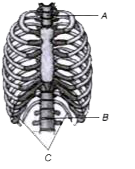What is significance of biconcave shape of RBCs.
Step-by-Step Solution
1. Understanding the Structure of RBCs:
- Red Blood Cells (RBCs), also known as Erythrocytes, have a unique biconcave shape. This means they are thinner in the center and thicker at the edges, resembling a doughnut without a hole.
2. Average Count of RBCs:
- In a healthy adult, the average RBC count is approximately 5 to 5.5 million RBCs per cubic millimeter of blood. This high count is essential for efficient oxygen transport.
3. Function of RBCs:
- The primary function of RBCs is to transport respiratory gases, particularly oxygen and carbon dioxide. They achieve this through a protein called hemoglobin, which binds to these gases.
4. Significance of Biconcave Shape:
- The biconcave shape of RBCs significantly increases their surface area relative to their volume. This increased surface area allows for more hemoglobin molecules to be present on the RBCs, enhancing their ability to bind and transport oxygen.
5. Oxygen Binding Capacity:
- Each hemoglobin molecule can bind up to four molecules of oxygen. The biconcave shape ensures that there is enough hemoglobin available for efficient oxygen transport throughout the body.
6. Facilitating Gas Exchange:
- The biconcave shape also allows RBCs to deform as they pass through narrow capillaries, ensuring that they can reach tissues and organs effectively for gas exchange.
Summary
The biconcave shape of RBCs is significant because it increases their surface area for gas exchange, enhances the binding capacity of hemoglobin for oxygen, and allows them to navigate through narrow blood vessels efficiently.
- Red Blood Cells (RBCs), also known as Erythrocytes, have a unique biconcave shape. This means they are thinner in the center and thicker at the edges, resembling a doughnut without a hole.
- In a healthy adult, the average RBC count is approximately 5 to 5.5 million RBCs per cubic millimeter of blood. This high count is essential for efficient oxygen transport.
- The primary function of RBCs is to transport respiratory gases, particularly oxygen and carbon dioxide. They achieve this through a protein called hemoglobin, which binds to these gases.
- The biconcave shape of RBCs significantly increases their surface area relative to their volume. This increased surface area allows for more hemoglobin molecules to be present on the RBCs, enhancing their ability to bind and transport oxygen.
- Each hemoglobin molecule can bind up to four molecules of oxygen. The biconcave shape ensures that there is enough hemoglobin available for efficient oxygen transport throughout the body.
- The biconcave shape also allows RBCs to deform as they pass through narrow capillaries, ensuring that they can reach tissues and organs effectively for gas exchange.
The biconcave shape of RBCs is significant because it increases their surface area for gas exchange, enhances the binding capacity of hemoglobin for oxygen, and allows them to navigate through narrow blood vessels efficiently.
Topper's Solved these Questions
- STRUCTURAL ORGANISATION IN ANIMALSBOOK - MODERN PUBLICATIONCHAPTER - STRUCTURAL ORGANISATION IN ANIMALSEXERCISE - NCERT FILE (NCERT EXERCISE QUESTIONS)
13 Videos
- STRUCTURAL ORGANISATION IN ANIMALSBOOK - MODERN PUBLICATIONCHAPTER - STRUCTURAL ORGANISATION IN ANIMALSEXERCISE - NCERT FILE (EXEMPLAR PROBLEMS) (Multiple Choice Questions)
10 Videos
- RESPIRATION IN PLANTS BOOK - MODERN PUBLICATIONCHAPTER - RESPIRATION IN PLANTS EXERCISE - CHAPTER PRACTICE TEST
16 Videos
- THE LIVING WORLDBOOK - MODERN PUBLICATIONCHAPTER - THE LIVING WORLDEXERCISE - Chapter Practice Test
16 Videos
Similar Questions
What is significance of BOD?
View SolutionWhat is significance of IUDs.
View Solution
What is the significance of C?
View SolutionWhat is significance of meiosis-II?
View SolutionWhat is significance of respiration ?
View SolutionWhat is the significance of meiosis?
View SolutionWhat is the significance of biodiversity ?
View SolutionWhat is the significance of mitosis ?
View SolutionWhat is the significance of chloride shift ?
View SolutionWhat is significance of connecting links?
View Solution
